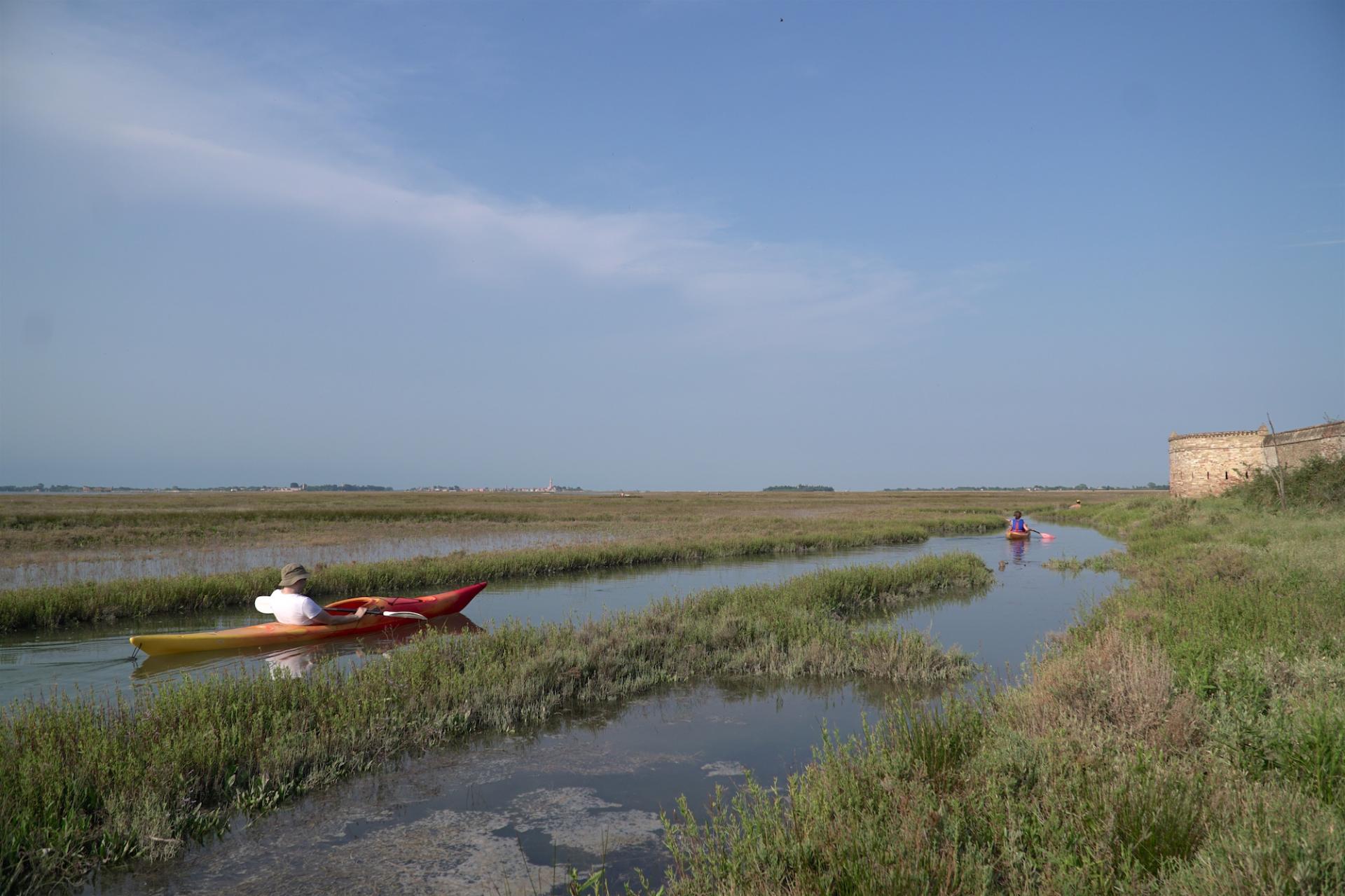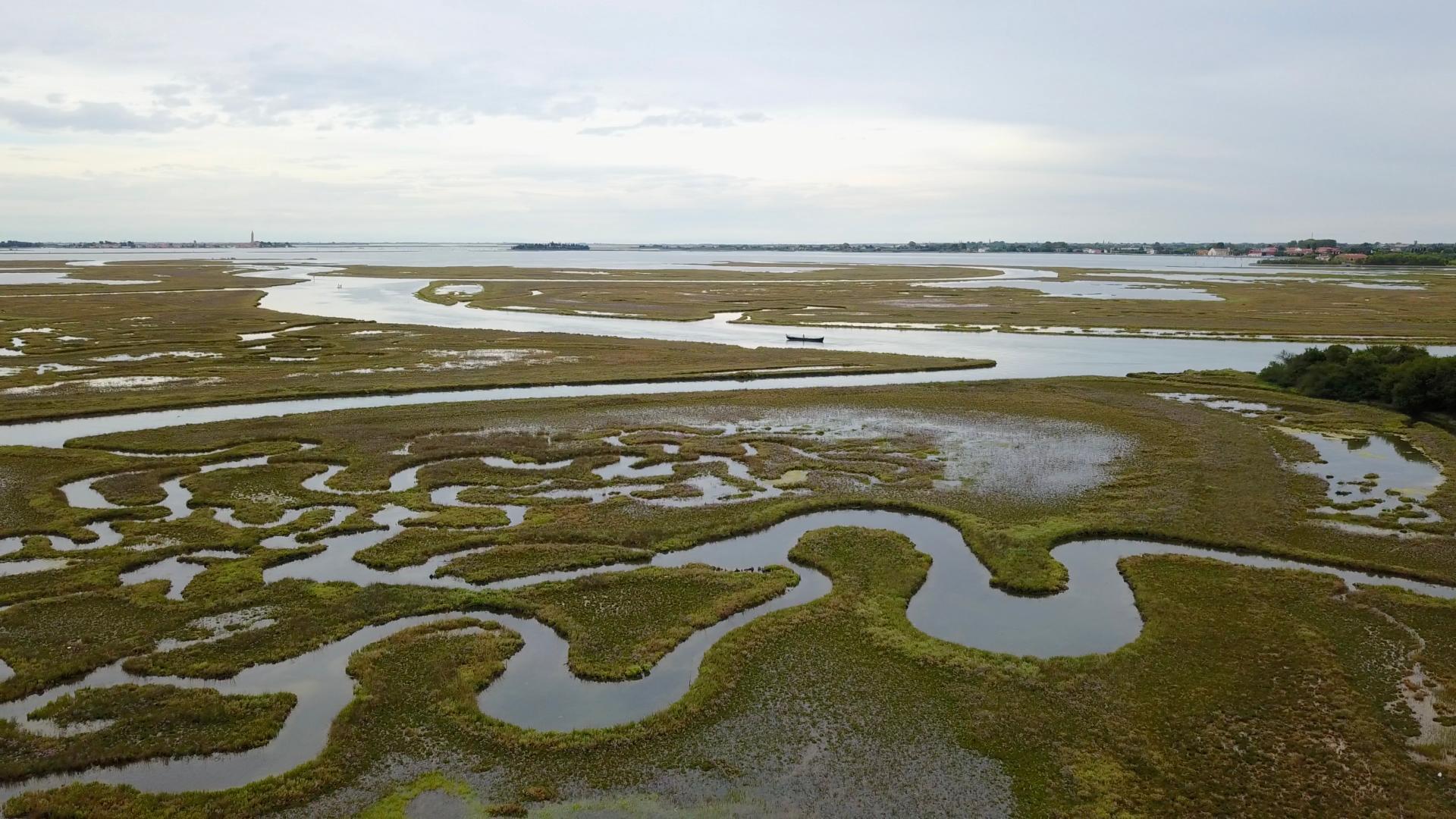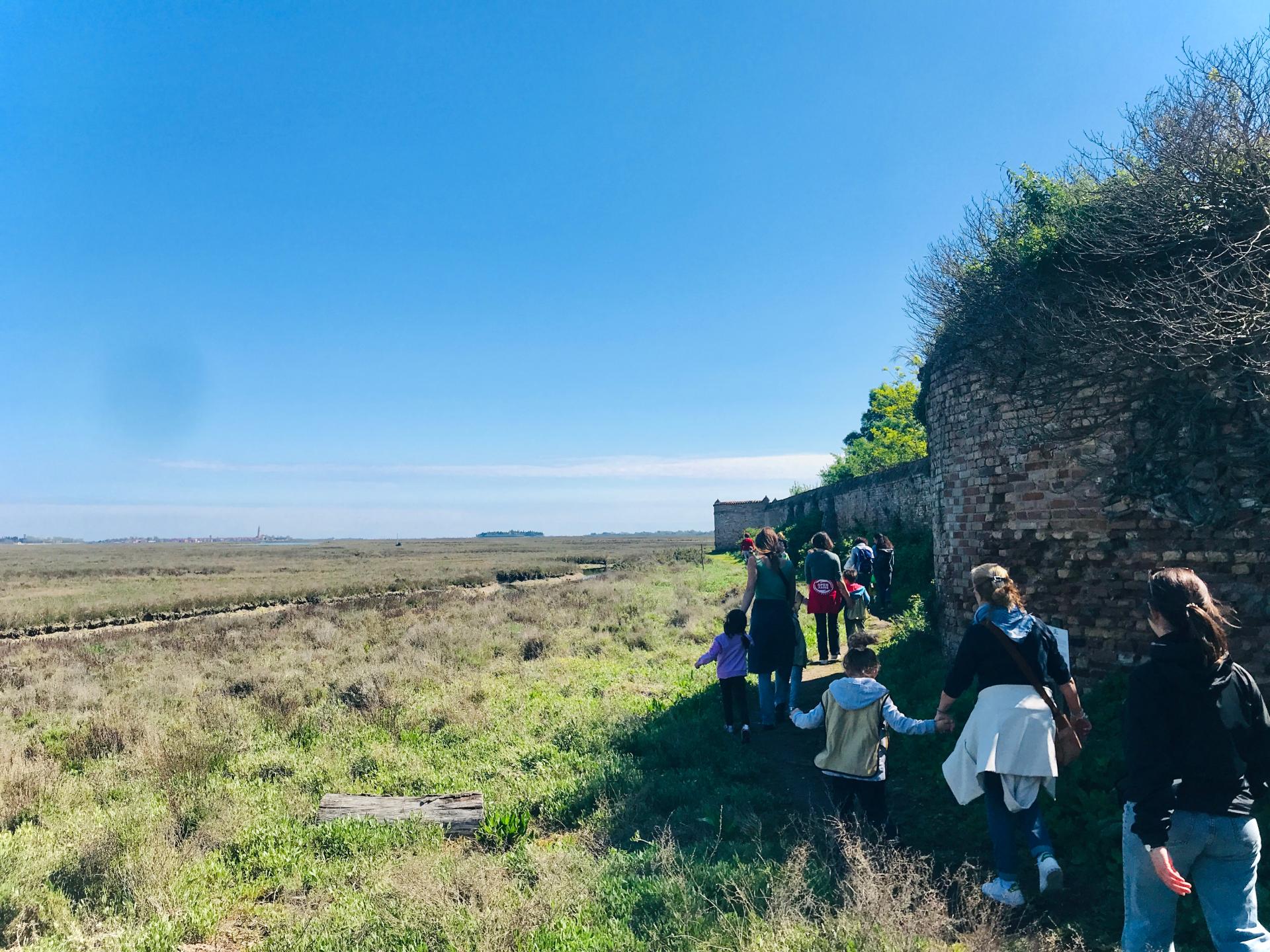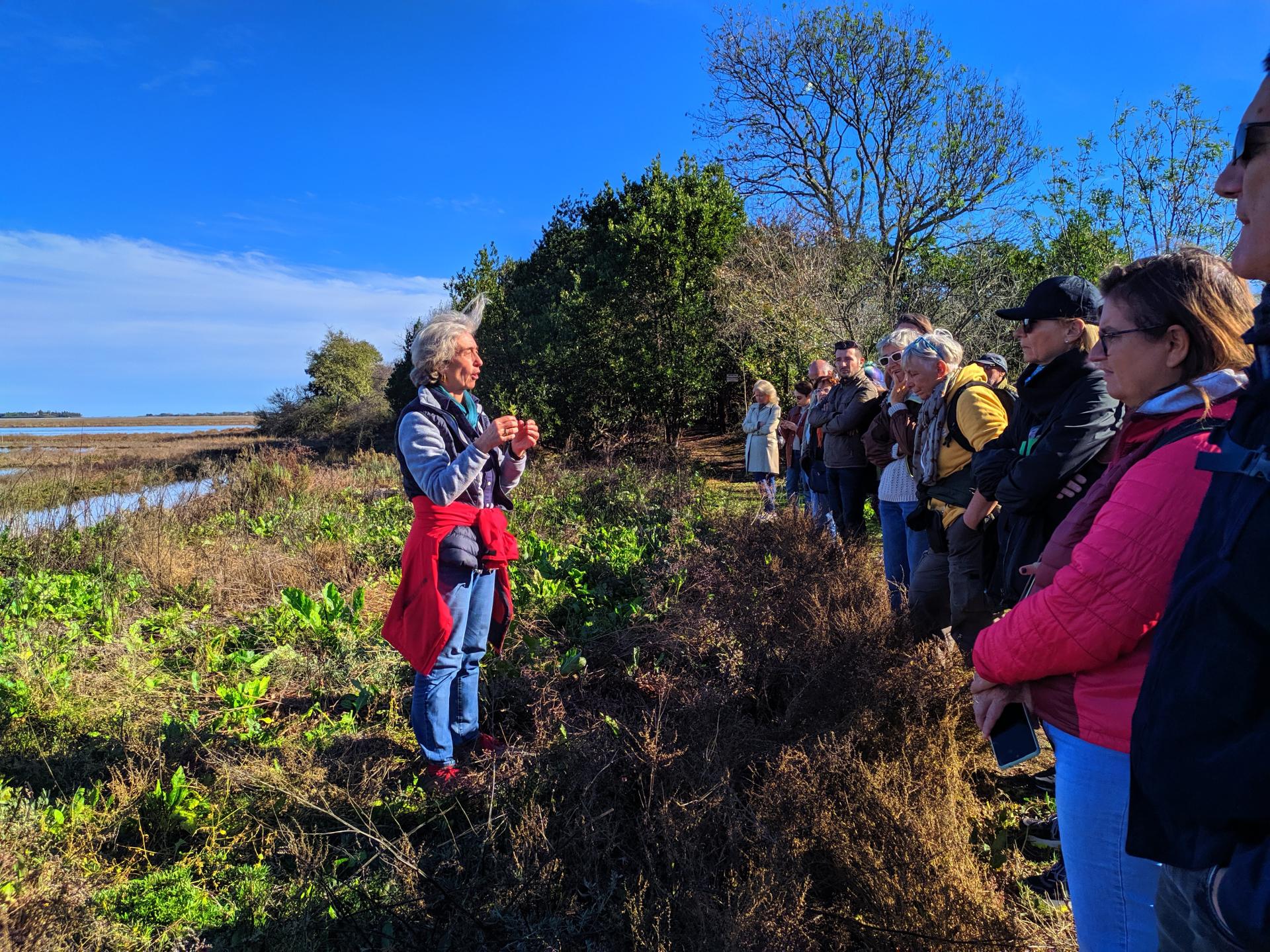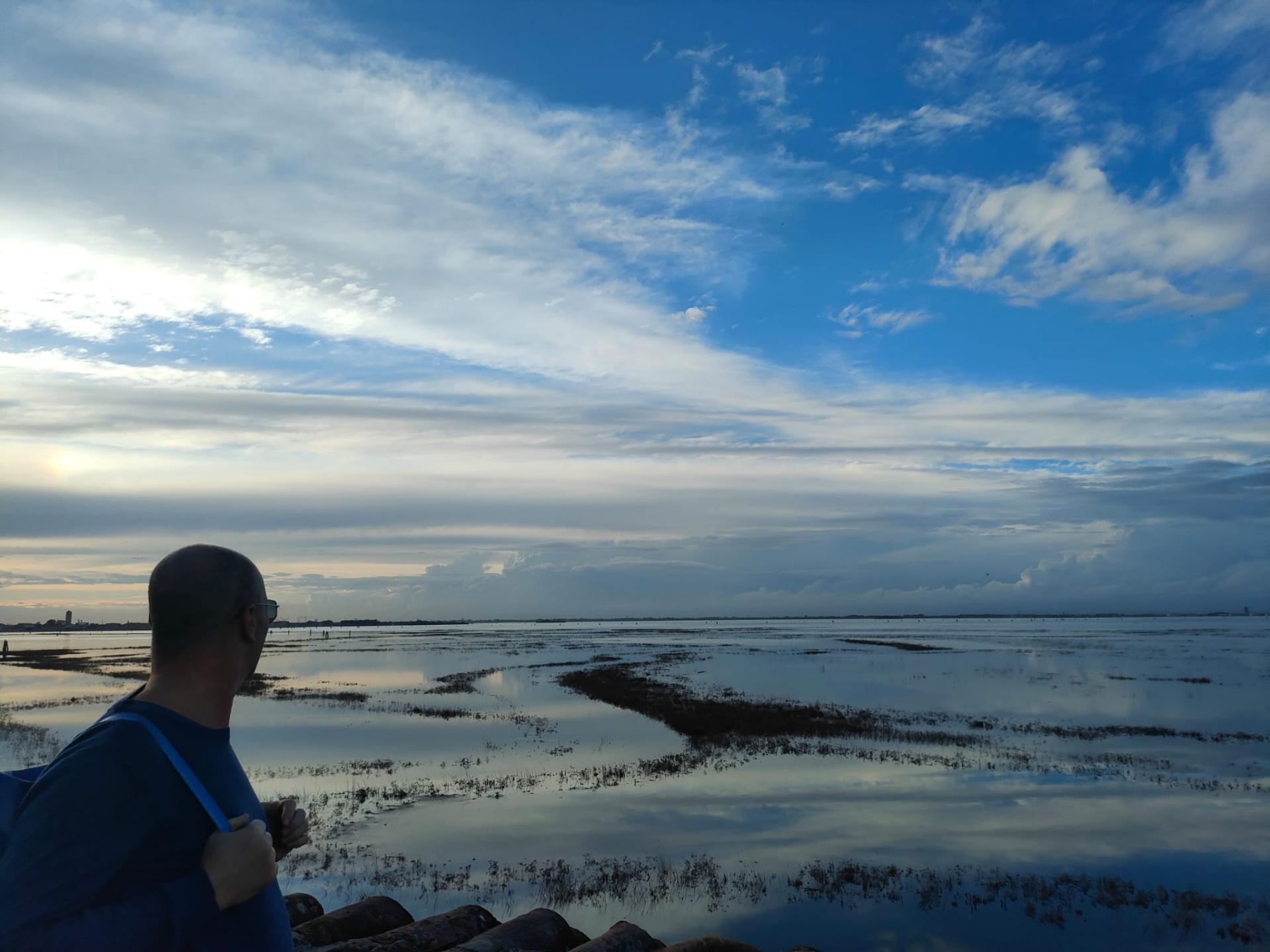The Path of the Barene
Basic information
Project Title
The Path of the Barene
Full project title
The Path of the Barene - a naturalistic project by the Lazzaretti Veneziani Ecomuseum
Category
Reconnecting with nature
Project Description
The Path of the Barene represents the naturalistic dimension of the Lazzaretti Veneziani Ecomuseum, located on Lazzaretto Nuovo Island, in the heart of the Venice Lagoon. The Path of Barene project has given new meaning to a path walked in the past for military purposes, that is now an immersive contemplative experience of nature, along the lively rumble of Venice, and an activator of environmental sensitivity and scientific curiosity for citizens and visitors of all ages.
Geographical Scope
Local
Project Region
Venice, Italy
Urban or rural issues
It addresses urban-rural linkages
Physical or other transformations
It refers to other types of transformations (soft investment)
EU Programme or fund
No
Description of the project
Summary
At the center of the best-preserved area of the Venice lagoon, part of the UNESCO World Heritage Site, rich in biodiversity and farming and fishing activities, the Lazzaretto Nuovo Island is a field outpost for the local area’s scientific institutions, schools, and other groups. The Path of the Barene displays the ecomuseum’s naturalistic side, serving as a frame and platform to collect and promote dialogue and the development of the various dedicated initiatives. Barene are the fundamental habitat of the lagoon ecosystem: saltmarshes that undergo recurrent floodings due to the tides and therefore host only a limited and peculiar flora, halophyte plants which adapted to co-habit with high-salinity and extreme conditions. They serve as an important litmus test of the relationship between humans and nature: taking this extraordinary singularity as its point of departure, the Path of the Barene is the ecomuseum’s nature walk: it is the only educational path dedicated to the lagoon environment. It is furnished with informative panels installed by the Venice Museum of Natural History.
The Path aims at promoting familiarity with an ecosystem, whose protection is more than ever crucial, against the progressive destruction and transformation of the environment and the social and productive fabric it supports: over the past century, 70% of the original barene have disappeared with powerful ecological, and also economic effects, as well as impacting on the inhabitants’ emotions and sense of identity. The Path has been walked by thousands of people of every age. The educational relevance of the project has been stated by the numerous and continued school visits. The high affluence of visitors is a prove of the high potential of this experience to foster life-long learning. As a consequence, the Path contributes to building a sense of place for the whole community, which, in turn, is motivated to foster conservation actions and behaviors of environmental safeguarding.
The Path aims at promoting familiarity with an ecosystem, whose protection is more than ever crucial, against the progressive destruction and transformation of the environment and the social and productive fabric it supports: over the past century, 70% of the original barene have disappeared with powerful ecological, and also economic effects, as well as impacting on the inhabitants’ emotions and sense of identity. The Path has been walked by thousands of people of every age. The educational relevance of the project has been stated by the numerous and continued school visits. The high affluence of visitors is a prove of the high potential of this experience to foster life-long learning. As a consequence, the Path contributes to building a sense of place for the whole community, which, in turn, is motivated to foster conservation actions and behaviors of environmental safeguarding.
Key objectives for sustainability
The approach by Lazzaretti Veneziani follows an action plan that is sustainable for people, the planet, and the furthering of the goals of Agenda 2030 and the innovative role of “heritage communities”, participatory and linked to the “genius loci”, as promoted by the Faro Convention of the Council of Europe.
The Path unveils many aspects of sustainability. Several ecosystem services in the lagoon depend on the Barene: high waters and flooding regulation, biodiversity conservation (nesting and feeding of birds, nursery for marine species, unique habitat for insects and marine microfauna), and resilience to climate change (SDGs 13,14,15). The project is also relevant for economic sustainability as it offers an alternative to mass tourism (SDGs 8,12). In this way, it also offers a more sustainable, slow-paced, and proximity tourism which contributes to developing place-based knowledge and curiosity in the variegated groups of visitors, thus resulting in high-quality education, especially outdoor education and life-long learning (SDGs 4, 10, 11). In this area, motor boats are not allowed to preserve the fragile balance of Barene ecosystem. Moreover, the ecomuseum hosts one of the first Italian plant-based wastewater treatment systems. This pilot project for the Venice lagoon was unveiled in Hanover, at Expo 2000. It is based on planting herbs that break down the pollutants contained in wastewater, which is treated before its release into the lagoon (SDGs 9, 11, 12). This system is just an example of alternative and nature-based solutions that can contribute to a more sustainable future. After the discovery of the rare Pinna nobilis around the Island, environmental quality indicator and largest bivalve in the Mediterranean, the ecomuseum joined the CNR-ISMAR project “Mappa la Pinna” inviting all lagoon visitors to report any sighting. The Barene along the Path are involved in monitoring by CO.RI.LA to study the impacts of climate change and MOSE system on the ecosystem.
The Path unveils many aspects of sustainability. Several ecosystem services in the lagoon depend on the Barene: high waters and flooding regulation, biodiversity conservation (nesting and feeding of birds, nursery for marine species, unique habitat for insects and marine microfauna), and resilience to climate change (SDGs 13,14,15). The project is also relevant for economic sustainability as it offers an alternative to mass tourism (SDGs 8,12). In this way, it also offers a more sustainable, slow-paced, and proximity tourism which contributes to developing place-based knowledge and curiosity in the variegated groups of visitors, thus resulting in high-quality education, especially outdoor education and life-long learning (SDGs 4, 10, 11). In this area, motor boats are not allowed to preserve the fragile balance of Barene ecosystem. Moreover, the ecomuseum hosts one of the first Italian plant-based wastewater treatment systems. This pilot project for the Venice lagoon was unveiled in Hanover, at Expo 2000. It is based on planting herbs that break down the pollutants contained in wastewater, which is treated before its release into the lagoon (SDGs 9, 11, 12). This system is just an example of alternative and nature-based solutions that can contribute to a more sustainable future. After the discovery of the rare Pinna nobilis around the Island, environmental quality indicator and largest bivalve in the Mediterranean, the ecomuseum joined the CNR-ISMAR project “Mappa la Pinna” inviting all lagoon visitors to report any sighting. The Barene along the Path are involved in monitoring by CO.RI.LA to study the impacts of climate change and MOSE system on the ecosystem.
Key objectives for aesthetics and quality
The Barene offers several cultural ecosystem services that contribute to the aesthetic experience thanks to its unique location. For instance, ecotourism, environmental education, and traditional recreational navigation are part of the ecomuseum initiatives. The natural environment of the Path can provide for physical and psychological wellbeing. Contact with biodiversity can contribute to human health through harm reduction, restoration, and building of capacities as forest bathing studies are enhancing. In the context of Venice, where green spaces are very rare, access to a lush and natural environment is particularly restorative for the community. The project makes this ecosystem available to the local community. The Path is easily accessible even without a guide thanks to the twelve panels projected together with the Museum of Natural History of Venice and designed by the architectural practice “DONTSTOP Studio”. The experience of the visit can be repeated over time to witness how the environment changes. To this scope, the Ecomuseum offers special visits of the Path, dedicated to the observation of seasonal changes, but also visits guided by experts. The Path of the Barene “from the air” is conducted by an environmental guide and ornithologist and is focused on birdwatching and biowathcing. The Path of the Barene “from the water” is a kayak excursion around the Island: it offers a different and more immersive point of view on this environment. The whole island undergoes constant maintenance to keep the place clean and pleasant. This effort is often noted and appreciated by visitors who can witness the care and dedication of the volunteers and are therefore more positively connected to the place. This immersive and educational experience can be easily replicated in similar environments such as other wetlands or former military areas. The Path offers an example of a partnership with important local cultural institutions and experts.
Key objectives for inclusion
The Path of the Barene is the only place in the Venetian Lagoon where one can see the Barene simply by walking next to them. Normally, this fragile environment can only be reached by boat (rowing) or seen from afar. The Island of Lazzaretto Nuovo can be reached by public transportation and the Path is included in every visit to the ecomuseum, making this environment accessible to hundreds of people every month.
Students, professors, and children under 14, can access the island with a reduced fee, despite the ecomuseum doesn’t receive any public funds to cover this reduction. The different kinds of visits offered encourage the participation of different categories of people. The Path, and in particular the tours guided by experts, offer a high level of dissemination and contribute to promoting lifelong learning, especially for those who are not at school age anymore.
The panels on the path are in Italian and English and display many images and illustrations, to make the explanation clear to everyone. Guided visits are conducted in Italian, English, and French. The immersive experience the Path can offer also makes it suitable for more sensorial explorations, beyond language. The Path can also be explored remotely with a video guide developed with one of our media partners, “Venipedia”. The Path is mostly flat, therefore it can be partially covered even with a wheelchair or by people with reduced mobility. The staff conducting the visits is very diverse, in terms of professional background, gender, nationality, and age. This is positively reflected in the visitors’ experience.
Students, professors, and children under 14, can access the island with a reduced fee, despite the ecomuseum doesn’t receive any public funds to cover this reduction. The different kinds of visits offered encourage the participation of different categories of people. The Path, and in particular the tours guided by experts, offer a high level of dissemination and contribute to promoting lifelong learning, especially for those who are not at school age anymore.
The panels on the path are in Italian and English and display many images and illustrations, to make the explanation clear to everyone. Guided visits are conducted in Italian, English, and French. The immersive experience the Path can offer also makes it suitable for more sensorial explorations, beyond language. The Path can also be explored remotely with a video guide developed with one of our media partners, “Venipedia”. The Path is mostly flat, therefore it can be partially covered even with a wheelchair or by people with reduced mobility. The staff conducting the visits is very diverse, in terms of professional background, gender, nationality, and age. This is positively reflected in the visitors’ experience.
Results in relation to category
The Ecomuseum that hosts the “Path of the Barene” project has witnessed a constant growth of visitors and requests over the years. In the past year, the island welcomed 6.000 visitors in seven months of opening, during more than 200 guided tours. The high visitors’ attachment is also witnessed by the lively online community, with 20.000 users on the Lazzaretti Veneziani website in the last year and a social community of more than 12.000 people. The Ecomuseum’s newsletter counts more than 6.000 subscribers (opening rate: 50%). More meaningful than numbers are the visitors’ testimonies which are astonished and surprised the first time they visit the island. After years of guided tours and special projects on the spot, the place where the Path is located became very powerful and significant, especially for its proximity to the Barene. Moreover, the competence and passion of the guides support the visitors in getting to know the place and therefore they build a special connection with it. The historical importance of the island also contributes to evoking a sense of place in people, especially in the local community that has the occasion to get to know its past, its present, and the threats and opportunities posed by the future. The fragile nature of the Barene environment is often key to making the visitors more aware of their surroundings and the social and environmental problems the city is facing. The Path has also a special significance because it was developed during Covid-19 epidemics, and it adapted well to respond to the needs of the community in times of pandemics, becoming a perfect place for outdoor education and to seek relief after months of isolation and distance from nature.
Another important result is the fact that the bottom-up no-profit revitalization of the island manifests itself in numerous projects. This continuous evolution makes the people hopeful and positively impacts the whole community, offering cultural and recreational activities.
Another important result is the fact that the bottom-up no-profit revitalization of the island manifests itself in numerous projects. This continuous evolution makes the people hopeful and positively impacts the whole community, offering cultural and recreational activities.
How Citizens benefit
The project has been benefiting the local community in many ways. Most importantly, it showed a strong educational potential. Every year hundreds of students, mostly from schools located in the metropolitan city of Venice visited the island since the Path was created. Youth is therefore made conscious of a unique environment and its functioning and can experience on the field what has been studied in the classroom. Outdoor education is also beneficial for other visitors of every age. Getting to know their surroundings, people have expressed a great attachment to the place, with a high rate of return and an active online community. For local people visiting the island means being able to regain access to a part of the territory with public transport, while the lagoon Barene are mostly experienced only by private boats owners. This is particularly relevant in the context of the Venetian lagoon where most minor islands are either abandoned or privatized. The (re)discovery of the Island normally triggers further interest in other lagoon islands and neglected places which can be seen through renewed lenses of tangible and intangible heritage, after the visit.
For university students, researchers, and professors the Island has always been an important outpost for the study of many different disciplines, and especially for the study of the lagoon ecology, biology, and conservation.
The local community is involved also through other initiatives related to traditional boats, sailing, and rowing, further contributing to the deep knowledge of the lagoon for already committed people, connecting them through sustainable and slow activities that allow the development of a sense of belonging. The ecomuseum also managed to involve people from the neighboring islands, such as Sant’Erasmo Island (project “F’Orti” dedicated to fortifications and gardens on that island) and Le Vignole (through direct collaboration with another organization called “VERAS”).
For university students, researchers, and professors the Island has always been an important outpost for the study of many different disciplines, and especially for the study of the lagoon ecology, biology, and conservation.
The local community is involved also through other initiatives related to traditional boats, sailing, and rowing, further contributing to the deep knowledge of the lagoon for already committed people, connecting them through sustainable and slow activities that allow the development of a sense of belonging. The ecomuseum also managed to involve people from the neighboring islands, such as Sant’Erasmo Island (project “F’Orti” dedicated to fortifications and gardens on that island) and Le Vignole (through direct collaboration with another organization called “VERAS”).
Physical or other transformations
It refers to other types of transformations (soft investment)
Innovative character
The Path of the Barene is part of a pioneering project in terms of non-profit territorial revitalization. The Path is a constituent part of the Lazzaretti Veneziani Ecomuseum, the only ecomuseum present and active in the Venetian Lagoon. The same creation of the ecomuseum is the result of a grassroots effort, which implemented a complex and ambitious project from below. Unlike traditional museums, this particular organization made the local community’s needs always the center and inevitably culminated in a unique cultural, social, and environmental experiment. The project is innovative also because despite focusing on the Path located around the island, it offers the opportunity to address the whole lagoon, as the ecomuseum also does with all its other activities. The project is also characterized by a high level of interdisciplinarity, as the result of the collaboration of many different actors and thus has the potential of unveiling further possible aspects of exploration. The Path can contribute to new kinds of education (eg. outdoor education, adventure education, learning by doing) by being a rich book to study and an optimal location for citizen science. The location offers the possibility to learn directly on the field, while also being guided by experts and by written content on the panels. At the same time, the Ecomuseum offers many digital resources through its website and the digital platform “Venipedia”, to get acquainted with this peculiar environment.
To conclude, what makes the project particularly innovative and hopeful is that it is located on the only island of the Venetian lagoon which has been saved from abandonment and given back to the community with no-profit activities.
To conclude, what makes the project particularly innovative and hopeful is that it is located on the only island of the Venetian lagoon which has been saved from abandonment and given back to the community with no-profit activities.
Disciplines/knowledge reflected
The Path of the Barene is deeply transdisciplinary, as it reflects the peculiarity of the island that hosts it. The naturalistic part of the ecomuseum is animated, among others, by archeologists, architects, ecologists, hydraulic engineers, educators and museum experts, university professors, and researchers. The plant-based wastewater treatment system on the island is an example of how the island can be an open-air classroom for university students: every year Franco Montalto – today a professor of Environmental Engineering in Philadelphia and involved in the implementation of the project during his Fulbright Research Fellowship in Venice in 1995 - leads a didactic workshop with classes from Drexel University. More recently, the island has started fruitful and stimulating collaborations with the Environmental Humanities Master Degree of Ca’ Foscari University of Venice. In this frame, the Island has also been a site for the development of students’ projects related to the 2023 edition of “Contamination Lab”, an innovative workshop dedicated to ecocritical paths in existing Venetian museums. The Ecomuseum also collaborated with the Department of Cultural and Environmental Heritage of the University of Milan, with the development of a workshop that explores the psychological attachment to place and the therapeutic effects of natural environments, through the lens of care.
Methodology used
The project use an interdisciplinary methodology aimed at expressing the complexity of the environment. The Path itself follows the old route the sentinels followed on their rounds, around the nineteenth-century bastions, between the “ghebi” (small canals between Barene), clumps of laurels, blackthorn, and reeds. The project aims to reactivate an ancient path with a new purpose and actively involve the visitors and the local community in observing and knowing their surroundings.
The Path of the Barene is part of the larger ecomuseum project for the revitalization of the Lazzaretto Nuovo Island: a bottom-up and volunteer-based initiative based on active citizenship and social responsibility. An example of the interdisciplinary approach followed by the project is the initiative “Climax Change”. For the occasion the Ecomuseum developed various activities related to the Path, over 13 months. These included environmental interventions to study a possibile ecosystem services certificaiton for the island (together with ETIFOR, a spin-off of the University of Padua), sharing of good practices with other local organizations, workshops for volunteers on Sustainable Development, the realization of an educational kit for schools, and special guided tours of the Path for the community.
In the project, a particular relevance is also in the naming. The naming “Sentiero delle Barene” (in Italian) catalyzed a renewed interest in this particular environment and on the island itself. In general, an important work of communication and dissemination has been made via the ecomuseum’s website, social media, and a newsletter, especially during lockdowns when visiting the island in person was not possible.
The Path of the Barene is part of the larger ecomuseum project for the revitalization of the Lazzaretto Nuovo Island: a bottom-up and volunteer-based initiative based on active citizenship and social responsibility. An example of the interdisciplinary approach followed by the project is the initiative “Climax Change”. For the occasion the Ecomuseum developed various activities related to the Path, over 13 months. These included environmental interventions to study a possibile ecosystem services certificaiton for the island (together with ETIFOR, a spin-off of the University of Padua), sharing of good practices with other local organizations, workshops for volunteers on Sustainable Development, the realization of an educational kit for schools, and special guided tours of the Path for the community.
In the project, a particular relevance is also in the naming. The naming “Sentiero delle Barene” (in Italian) catalyzed a renewed interest in this particular environment and on the island itself. In general, an important work of communication and dissemination has been made via the ecomuseum’s website, social media, and a newsletter, especially during lockdowns when visiting the island in person was not possible.
How stakeholders are engaged
Many public agencies have supported the project targeting the rebirth of the Island of Lazzaretto Nuovo over the years, with the ultimate aim of creating a museum, through direct funding or by issuing calls: the Ministry of Culture, the Venice Water Commissioner, the Veneto Region, the European Union, the Municipality of Venice. The Municipality of Venice holds the property of the island and it is a key local stakeholder for the ecomuseum. The Ministry of Culture also plays a pivotal role in any ecomuseum’s project as it is hosted on the island, for its Deposit of Archeological findings of lagoon origin. For the development of the Path, the tight collaboration with the Museum of Natural History was fundamental. The Path and its contents are the result of a co-projectation with the museum’s experts. At the larger level, the Path also involved a number of national and international visitors, which participated in the dedicated visits. In particular, more than 10 Italian and international universities have chosen the island as a field research outpost, for different disciplines. In 2019, at the beginning of the project, a three-days workshop dedicated to the landscape and naturalistic aspects of the island was held. It involved participants from the local community and experts and was dedicated to the maintenance and care of the island and the Path, and included excursions to the nearby islands and naturalistic sites. The local population and the ecomuseum’s community have always been involved in the maintenance of this area of the island, thanks to “Eco Day”.These are participatory events that promote interest in and protection of the lagoon environment. Volunteers are directly involved in the cleaning of the Lazzaretto Nuovo’s shoreline and the banks of the surrounding waterways, as well as those of other islands, picking up cubic meters of detritus from our consumer society, coughed up by the high tides in winter.
Global challenges
The project successfully tackles global challenges by activating people locally and attracting visitors and . The Path addresses most of the environmental problems we are facing today: biodiversity loss, climate change, and pollution. A specific emphasis is put on how the problems we witness with our eyes at the local level are part of larger and more complex phenomena, that are intrinsically connected with one another. Motor boats and the traumatic transformations of the lagoon in the last century are a challenge for the survival of this peculiar habitat, that around the Path is protected in order to allow the life of the ecosystem that is enhanced through divulgation and collective experiences.
The project also contributes to addressing social problems such as the disconnection from nature and the unavailability of green spaces, which is a relevant problem in the Global North at large. This is distinctly evident in Venice, where green spaces are limited and private gardens are hidden from view by high walls, while local lagoon traditions such as sailing and fishing are disappearing. In this asset the Path is a urban actor offering relief and the possibility to reconnect with the lagoon life in a perspective of regeneration for mutual benefit.
The project also contributes to addressing social problems such as the disconnection from nature and the unavailability of green spaces, which is a relevant problem in the Global North at large. This is distinctly evident in Venice, where green spaces are limited and private gardens are hidden from view by high walls, while local lagoon traditions such as sailing and fishing are disappearing. In this asset the Path is a urban actor offering relief and the possibility to reconnect with the lagoon life in a perspective of regeneration for mutual benefit.
Learning transferred to other parties
The project can be exemplary for other ecomuseums to address the role of nature and its importance for the local community. The project includes different activities which aim at this scope, through immersive, educational, and first-hand experiences that can be easily replicated in other contexts (eg. focus on specific elements, different means of transportation, observation of seasonal changes, activities for schools). The Path could also be transferred to other areas of the Venetian lagoon, as the guides are prepared to talk about the lagoon as a whole. Similarly, it could also be transferred to other wetlands or natural environments at risk which would benefit from renewed attention. Moreover, the ecomuseum-museum collaboration could be replicated. The Museum of Natural History, like other similar museum institutions (eg. city museums), would benefit from moving outside its walls and creating similar projects that will reach a different audience. Another good practice that can be replicated is the collaboration between the ecomuseum and the local and international universities. This is a win-win relationship in which university students and researchers can visit important environmental and naturalistic outposts while contributing to their development through research and the availability of experts. The Path of the Barene exemplifies a good and replicable practice aiming at disseminating the complexity of a peculiar environment, through the physical and psychological wellbeing offered by the place where it is located, coupled with a deep understanding and consciousness of the threat posed to a specific environment.
Keywords
biodiversity
community
ecosystem
heritage
outdoor education

